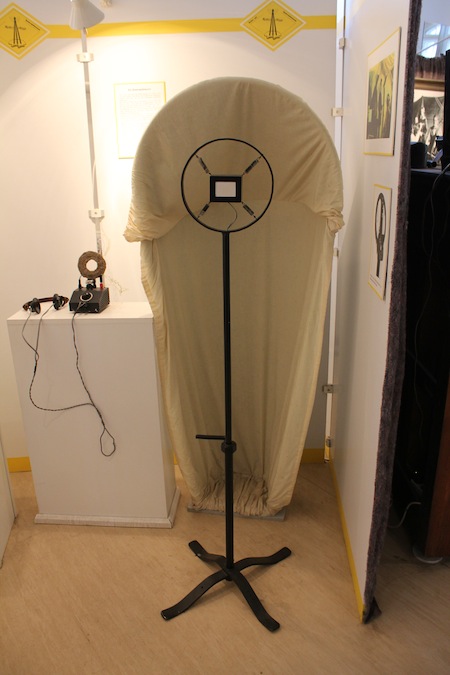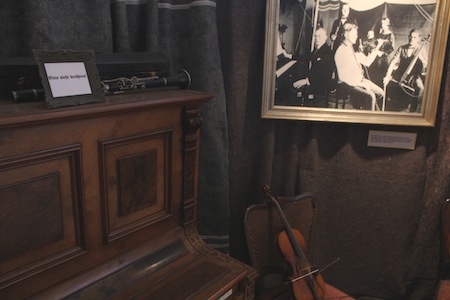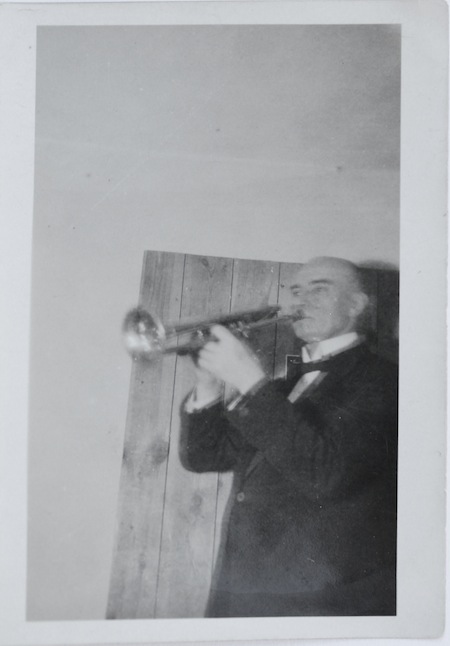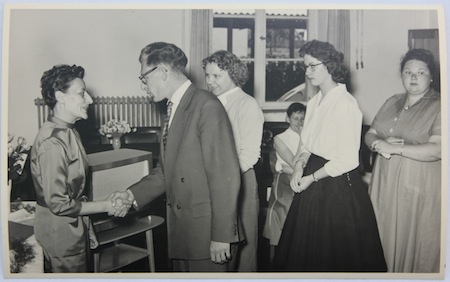radio technology museum Königs-Wusterhausen, part 3, radio broadcast
After a brief history of the radio technology museum Königs-Wusterhausen on the “Funkerberg” (“broadcast hill”) and an overview on the impressive Dieselgenerator here now part 3 of the series. Part 3 deals a bit with the radio broadcasting itself and in particular with the role it played within my family.
The concrete broadcasting technology had a strong impact on the success of radio broadcasting itself. The museum documents this very lively and displays a lot of original technology.
So next to collections of vacuum tubes there are partially rather detailled documentations about particular devices, which had pushed technology forward.
Like a documentation about the cathode-beam relay, invented by von Lieben. The german text “Die Einführung der Lieben-Röhre revolutionierte das Funkwesen” translates as “The introduction of the cathode-beam relay revolutionized broadcasting”.
Here the text says “Transmission tube for big power” (1980-1990).
Radio life itself started rather humble. The first emissions were done by the technicians at “Funkerberg.” In fact they formed a little “orchester” which produced the music which was then transmitted.
A lot had to be improvised like here a microphone shielding with a bath tub.
A little dark corner covered with thick fabrics served as an improvised studio it displays now a photo and the instruments of the technicians.
Later on though performances and performance venues got more elaborate. Here the Funkerbergs performance hall which serves now as a general purpose culture hall (“Kultursaal.”)
My greatgrandfather Gustav Schellhase, father of Gerda played as a cellist in the Berlin broadcast orchester, as I was told. I haven’t yet seen any documents though and as one can see above he apparently did not only play the cello. If you know more about the musical life of Gustav Schellhase – please let me know.
Radio broadcasting included of course not only music performances but was able to serve political interests. In fact as already mentioned in part 1, radio broadcast was initially forbidden. During the Nazi reign the “Volksempfänger” played an incredible important role in the dissemination of Nazi propaganda. The museums exhibition documents the political role of broadcast. “Der Rundfunk als politisches Machtinstrument” translates to “Radio Broadcast as political power instrument”:
And so the museum has also a rather big collection of radios.
One of the bigger if not the biggest german producers of radios and radio technology has been the electrical engineering company Siemens which has still a rather big settling here in Berlin, which includes the architectural landmark “Wernerwerk.” There is even the locality “Siemensstadt” (“Siemenstown”). Both my grandmothers and both of my parents had worked for Siemens. I also worked there briefly as an intern and I think even my preschool might have originally belonged to Siemens. My father worked temporarily even directly in the “Radiowerk” (“radiofactory”).
In the above image you can see my grandmother Annemarie (on the left) on the occasion of her 25th anniversary for working for Siemens (if I remember correctly). People queue to congratulate her. The image was done in the late 50’s. As an anniversary present she received a Siemens radio with table (in the background). I still have the radio and the table. The radio needs some repair but it still works and has a magnificient sound.
Annemarie had been working as a secretary for rather high ranking executives of Siemens.
During WWII Siemens had a factory near Ausschwitz. Annemarie told me, that within the company there were quite some tensions about how to deal with the Nazi’s and that her boss had told her that he can’t tell her what exactly is happening with people in concentration camps but that “terrible things” happen there. She was never a member of the Nazi party but on the other hand she never engadged in open resistance. Due to her considerably high position she was one of the main income sources for the family, which included her mother, her two children (born during war time) and after her brother died in WWII she cared partially also for the five young children of her brother and his wive.
radio technology museum Königs-Wusterhausen, part 1
radio technology museum Königs-Wusterhausen, part 2, the Dieselgenerator













June 20th, 2017 at 8:41 am
Please don’t take this as an offense but frankly your grandmothers facial profile looks like a caricature from “Der Stürmer”. Did she have problems due to that during the Nazi time?
June 22nd, 2017 at 11:08 am
Frankly I am not so sure which facial features you are concretely referring to. The pronounced nose? Do you think she looks jewish or non-jewish by the criteria as set in “Der Stürmer” ? Like if I look at this comparision in “Der Stürmer” it seems that the form of chin and forehead etc. also played a role. But in general although the Nazi’s put quite an effort into categorizing humans via external body features, like via anthropometrical studies this was –even by “Der Stürmer”-standards* apparently only seen as something as a supplement and/or workaround to genetic considerations. But since the Nazi’s didn’t have nowadays DNA sequencing methods at hand they based e.g. their decisions on who is “of german blood” (Deutschblütiger) or of “jewish blood” according to the Nuremberg Laws usually on the affiliation to a religious group.
So in short – I don’t remember that my grandmother mentioned that she had problems due to her nose or so. Her brother put together a detailled ancestry map, which reaches back into the 18th century. The map seemed to have been quite an effort, because he had to get a stamp of every registry, where the corresponding ancestor was born which certified the affiliation to a christian church. And I think he didn’t do this because of physignomy problems, but because he wanted to marry. But even if there would have been problems – by this document he and Annemarie were clearly “of german blood”.
*translation:
“Der Fluch im Blut” : “Malediction in the blood”
“Ein jedes Jüdchen wird ein Jud”: “Every jewish child grows into a jew”
July 24th, 2017 at 2:51 pm
I wrote:
.
In fact sofar all what I remember from her accounts is that as a child on the occasion of “Kaisers Geburtstag” (the festivities around the birthday of Wilhelm second) she had to wear her hair open (usually her hair was in braids), because she had long golden blond curly hair like angels are often depicted with, moreover long golden blond curly hair had a special symbolic and political meaning*)
She hated it, because the combing afterwards was an ordeal.
*Since the Wikipedia article is in german, here a brief explanation. In the german wars against Napoleonic occupation Ferdinande von Schmettau wanted to follow the war fundraising call “Gold gab ich für Eisen” (“I donated gold for iron”). In that call Princess Marianne of Prussia asked in 1813 women to donate their jewelriy in exchange for an iron ring or brooch with this inscript. But since Ferdinande hat no gold, she cut off her blond hair and sold it for 2 Talers. The fundraising call “Gold gab ich für Eisen” was repeated for the occasion of the first world war.
->wikipedia image Ferdinande von Schmettau sacrifices her hair on the altar of the fatherland
August 5th, 2017 at 8:38 am
Seriously: do you think this is an appropriate topic for a physicists blog? Apart from the fact that hobby-historians are usually rather blurring the past centuries than elucidating them, who the hell cares at all about napoleonic occupation?
August 8th, 2017 at 8:40 am
I do think one can learn from history that is there are often events, which have parallels at other space-time points. That is certain dynamics are strongly related to ressources and population dynamics and cultural/technological development. Unfortunately this is as such not always very visible in historic texts. Like when I was in school we had around the 8th, 9th grade mainly european history as a topic, which seemed like an endless sequence of feudal fights and treaties. I was complaining back then to my teacher Ms. Krailler-Link (thats how I remember she was called) about that and asking why we are not provided with more information about the living conditions, rites, cultures etc. but I was told this is how history is supposed to be according to “Lehrplan”.
The French–German enmity had played an important role in european history in the last centuries and the Napoleonic wars had played a key role in that, Wikipedia writes:
->Napoleon at Brandenburg gate
The Napoleonic wars and also the following Franco-Prussian war were part of a conflict that played a major role in WW I, Wikipedia writes:
The enmity was officially terminated with the Élysée Treaty.
By the way it is also that the Napoleonic wars or the Franco-Prussian war were not that far ago, at least there even exist an anecdote within my family from that time.
August 11th, 2017 at 6:30 pm
So let’s hear the ancedote.
October 23rd, 2017 at 8:04 pm
forensics wrote: “So let’s hear the ancedote.”
OK here the story as even written up by a relative of me, who is now in his eighties. It is about a common relative called uncle Emil (the brother of his grandmother).
Here my english translation:
October 27th, 2017 at 9:33 am
“…he however didn’t so much invest into his work at his farm at Schwessin.”
sounds like uncle Emils relatives were not so happy with his engagement in fairground booths.
June 12th, 2018 at 11:07 am
nad wrote:
Did you believe her?
June 13th, 2018 at 9:03 pm
@A. Hamburger
Yes I believed her. I should also mention that she stopped working during the war, because of pregnancies. That is the conversation took probably place before the Wannsee Conference, because the first birth was in 1942. As far as I understood it is unclear how much her husband knew and by the way also her brother, at least what I remember from talking with her this topic was never discussed during these times it seemed it was rather avoided.
July 29th, 2018 at 9:45 am
Her brother? You haven’t said sofar anything about that brother. What did he do during WWII?
August 1st, 2018 at 10:38 pm
I don’t know, but there are rumors that he may have worked in concentration camp Dachau.
December 2nd, 2018 at 10:00 am
Are you sure it was Dachau and not death camp Chelmo for example? Aren’t you afraid that revealing your Nazi past on the internet could be dangerous for you?
December 5th, 2018 at 11:20 am
I am not a native english speaker, but it seems to me that the expression “your Nazi past” sounds as if I have actively participated in activities by Nazis. In case you have doubts about my age: already my parents were too young for being able to participate in Nazi Germany – they were toddlers when WWII ended. Moreover my grandfather died when I was about 1 year old and my great uncle, about whom I was talking here died in a russian prisoner camp rather directly after the war. Those two: my grandfather and my great uncle were the only members in my closer family who had a “bigger” role in Nazi Germany – as far as I know. In particulear both were punished for their deeds.
No I am not sure. As I said this were just rumors and it seems -if at all- then he did not work in Dachau directly, but was eventually involved in the organisational side. That is as far as I know he was mostly situated in Berlin during the war.
Even my great uncles kids don’t really know, what he did, they were very small when he died. Apparently there exist some documents, but they don’t reveal what his tasks were, but just ranks etc. It should also be pointed out that everything which concerned concentration camps was top secret at the time. There are though some indirect clues that he did very bad things, like after the war his wife had problems to obtain housing in GDR. She got to hear sentences like: ” You and your breed should be happy to be still alive.” A relative recently said: “One has to remark that he probably died in a way he made other people die”.
I thought quite a bit about whether I should write something about my family and especially about my grandfather or my great uncle. I do think though that histories of ordinary individuals may bear information, which might be not so apparent in historical descriptions. They are important as a supplement for understanding the courses of history.
People have denied to shake hands with me two times or so, without knowing that some of my relatives were Nazis, but simply because I was german. Every german knows that a quick lie to be dutch or danish might eventually help to keep holiday memories nice. I had a couple of more or less scary encounters related to the fact of being german. So yes it might have negative consequences to publish this here. I hope though it won’t be dangerous.
I don’t know why you ask specifically about Chelmno. My great uncle and my grandmother lived in his early youth and childhood rather close to Chelmno.
My great uncle was very young, but still old enough to participate in WWI. I think he got injured, at least he was declared missing for quite some time. Around that time his father died due to the circumstances of a siege. His mother and his about 16 years old sister (my grandmother) were forced or at least felt forced to leave their home (as a consequence of the Versailles treaty). So he lost his father, his home (inluding basically all belongings) and his youth and good health back then.
In short: as far as I know he had nothing to do with Chelmno camp apart from being close to Chelmno in his youth, but as already said -I don’t really know what he did.
August 31st, 2019 at 9:14 am
But don’t you think that kings and leaders play the decisive role in history?
October 23rd, 2019 at 6:42 pm
Regarding your comment about the French-German enmity– it should be pointed out that this enmity was to a great extend just a French-Habsburg rivalry probably culminating in the Nine Years’ war where Louis XIV attacked Leopold I despite the fact that Leopold I was already fighting a war against the turkish empire. The “sun king” had obviously a warrior gene.
October 27th, 2019 at 1:42 pm
@forensics
@Daisuke R. Koiyama
Leaders surely take an important role in the course of history, how free their decisions were has however been varying in the course of history.
And even Louis XIV and Leopold I will had had -to some extend-been forced -or feeling forced- to act as they did. In particular it is not so that they had no other things to do than politics and wars. That is -as far as I understood- Louis XIV is called the “sun king” not because of the size of his empire (that was actually rather a akkadian,egyptian,persian and/or Habsburgian connotation) but because in his youth he was an accomplished ballet dancer who represented among others the rising sun. And Leopold I was a rather accomplished musical composer. (Here a link to what is claimed to be a piece by him: The “Missa pro defunctis” (1673)). And he was of course not the only “politician” who composed (here another example by Wilhelmine von Preußen.)
October 30th, 2019 at 9:02 am
Leopold I and other allies did not have such a big role in the defense of the Netherlands. When Louis XI invaded the Netherlands:
October 30th, 2019 at 11:01 am
Meen lieba Scholli! Dit is aba ne Menge Penunsn! Naja war ja schon imma nich so billich die Puppn tanzn zu lassn.Alleene die Kostüme! Und die Hütte hat ja wahrscheinlich och’n bisken jekostet.
Watt is’n 16 million guilders in Euro?
May 1st, 2020 at 9:40 am
You should have pointed out that the ability to dance well was a kind of prerequisite for participating at court life. And this was not easy. Wendy Hilton writes: It is not possible to distinguish between a ballroom and theatre dance unless the score contains some of the elaborate pas de ballet used only in theatre dances. ….The ballroom dances a deux choreographed for aristocratic society were designed to be danced by one couple at a time by strict order of social precedence. That is since already the ballroom dances were quite elaborate, the theatre dances had to have some difficult extra steps, and sometimes the theatre pieces required to dance and to play castagnettes while dancing:
Like in the Dissertation by Juergen Eppelsheim p. 172 it is detailed that the use of castagnette was not only atttested for the „Pastorale comique” but also for the Ballett „Le Triomphe de l’Amour”. La Laurencie is reporting on p. 190— 195 des „Mercure galant” January 1681: „Le clou de la pièce consistait en l’apparition de la toute jeune M llc de Nantes (elle n’avait pas huit ans) dans la dernière entrée; la petite princesse y jouait des castagnettes et mettait en relief son ‘agrément pour toute sorte de danse’ “ (p. 57).
Of course this high sophistication of court life was hard to obtain and maintain and in fact one of Lully’s pieces, namely Le Bourgeois gentilhomme “satirizes attempts at social climbing and the bourgeois personality, poking fun both at the vulgar, pretentious middle-class and the vain, snobbish aristocracy.” In particular the main character in that comedie-ballet: “applies himself to learning the gentlemanly arts of fencing, dancing, music and philosophy, despite his age; in doing so he continually manages to make a fool of himself, to the disgust of his hired teachers.”
October 17th, 2020 at 6:15 pm
We all know that nowadays even a middle class merchant doesn’t need to learn ballet dancing and singing in order to marry an aristocrat
And even if these historical reminescences may certainly be interesting for some folks I would prefer to have this discussion going back to the previous discussions about Nad’s family.
Nad -do you have more stories, like the one about the lazy farmer?:
By the way Świeszyno (Schwessin) is not very close to Chelmno. What happened?
December 3rd, 2020 at 7:37 pm
I was talking about two different families. One family is from my mother’s side, the other family on my fathers side and besides the fact that they had been living in Pommerania the families had nothing to do with each other – as far as I know. The family close to Chelmno was already displaced after World War I and partially again in World War II.
The story about Schwessin appears in written recollections about life as a child during world war II and the family’s forced displacement after World War II and I actually don’t know which Świeszyno is meant here.
December 4th, 2020 at 7:26 am
The recollections include recollections about rape and killing of civilians, including the ones that he had to watch his mother beeing gang-raped by drunken soldiers and then been thrown unconscious and bleeding onto the dunghill and how the neighbor family, who was hiding in a barn with their six daughter at another rampage was shot at and then burned alive with the barn.
December 5th, 2020 at 6:24 pm
Thank you for sharing informations about the whereabouts of some family members. What you just presented is though a very subjective perspective. I am lacking the broader historical context. We speak here about german Nazi families during World War II, right?
December 5th, 2020 at 7:45 pm
@a contempary historian at an academic institute
According to the recollections -this what I called “rampages” took place after march 6, 1945. The rampages were done by soldiers which were more or less returning home. The forced displacement was May/June 1946. And yes these are subjective recollections – as I said that these were the recollections of someone who was a school kid back then. For more context here is a translation of what he recollected about the killing of the family with the six daughters: